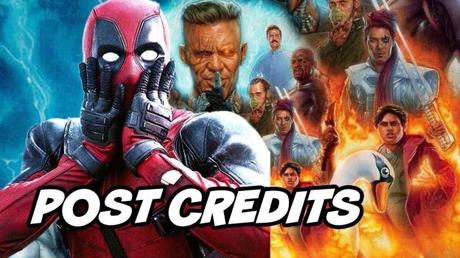The movie theater industry is entirely content-dependent. When there are enough movies in any given year that people want to see, the annual P&L figures are gonna look good; when there aren't, there's only so much spin artistry you can pull to shine that turd. That doesn't, however, mean there aren't things movie theaters can do improve the moviegoing experience and in some small way help 2018's box office momentum continue into 2019.
Below are 5 suggestions I have. Very few of them, if I'm honest, have any chance of happening, but maybe they should. We are a perpetually distracted populace these days, and so much of the moviegoing experience seems designed to tax our increasingly limited patience. It doesn't have to be that way. Read on and then use the comments to let me know what you think or if you have any suggestions of your own.
1. If your movie has a post-credits scene, include a disclaimer saying as much at the very start
Once upon a time, a post-credits scene was a rare Easter Egg to be discovered by those who, for whatever reason, didn't have anywhere better to be once a movie ended. These Easter Eggs rarely meant anything to the overall plot. They were just little bonuses, real treats for the fans. Giving us a heads-up about them beforehand would have eliminated the sense of discovery and fun.
Marvel Studios has changed all of that. Now missing a post-credits scene can mean missing out on one final plot point or an incredibly important set-up for a sequel. So, we know that no Marvel Studios movie is truly over until the theater ushers come and tell us to leave.
Not so much with the competition. Some include multiple post-credits scenes just like Marvel, others stick with none. We never really know for sure. Just about a million think pieces were written about Vice's post-credits scene, for example, yet you might have missed out on what angered so many critics because who would have guessed an Oscar movie would have a post-credits scene?
It's time to end this. Just tell us beforehand if we need to sit through the credits or not. Many of the below-the-line crew members might object, as forcing audiences to sit through credits is just about the only way the average movie fan will ever see the name of the first assistant to the director or second unit camera person, but a captive audience is hardly the most ideal crowd to receive this kind of information.
That would surely drive down the Google hits for "Does [Insert Name of Movie] have a post-credits scene?" queries, most of which are madly typed into phones while people sit through 10 minutes of credits not knowing if they can leave the theater yet. Ad-dollar starved sites will be robbed of guaranteed clickbait, but it's worth it as a public service to the fans.
2. All sequels must now include very brief recaps of the prior films.
If movies insist on basically becoming big budget, unending TV shows you should at least try to help the audience remember the most important stuff from last episode exactly the way real TV shows do. The Mission: Impossible already does this kind of thing through cleverly edited opening credits sequences. The Sam Raimi Spider-Man sequels did the same. So, it can be done in a creative way.
3. Declare a two-year moratorium on the Fred Flintstone plot.Being hit on the head and waking up a different person or in a fantasy world might have been okay when it happened to Fred back in the 1960s, but there are other ways to introduce this kind of high-concept storyline. For a long time, Hollywood seemed to realize this, but now in the span of 18-months a knock in the head will have made Amy Schumer believe she woke up looking like a supermodel ( I Feel Pretty), transported Vincent Elbaz's chauvinist into an alternate universe where gender roles are reversed ( I Am Not an Easy Man), helped kickstart Taraji P. Henson's ability to hear men's thoughts ( What Men Want), and delivered Rebel Wilson to her very own PG-13 rom-com universe ( Isn't It Romantic?).
Whenever we have a clustering of the same plot point like that, it's time to force a break. This would help improve the moviegoing experience by virtue of eliminating the nagging "didn't I just see that?" thought more casual moviegoers might have as they struggle to differentiate between the group.
4. Re-think some of the pull-quotes you use in trailersIf the marketing plan for your female-driven drama is to use a bunch of pull-quotes from critics celebrating the movie's diversity make sure that at least one of those quotes comes from a female critic. Looking at you, Gloria.
Speaking as one myself, male critics are certainly capable of appreciating and championing female-driven movies, as Playlist's Victor Siff, ScreenDaily's Allan Hunter, RogerEbert.Com Brian Tallerico, and Variety's Peter Debruge clearly do in the trailer, with the latter calling Gloria "one of the great female-led films of the 21st century." But when you're whole marketing angle is basically "Ladies, this one's for you!" maybe find a female critic who agrees with you.
5. Limit the number of trailers which play before all moviesI never realized how privileged I had been as a film fan until two years ago when I attended my first Regal Theater - the #2 theater chain in North America - during an out-of-town trip. It was a late night showing of Baby Driver, which had just opened, and to my astonishment and horror Regal tacked on 25 minutes (!) worth of trailers before Edgar Wright's B-movie masterpiece could unfurl. Just for context, Baby Driver itself is only 113 minutes long. Making us sit through nearly half an hour trailers is equivalent to over a quarter of the film's run time. No movie should be preceded by that much sitting and waiting for the damn thing to start.
My beloved, family-run theaters back home knew better than that. They only ever dared put 9 minutes of trailers before every movie, as the Good Lord of Cinema intended.
Then that theater chain was bought by Regal.
Then AMC, the #1 theater chain in the land, built its first location in my town.
I've been sitting through so many trailers ever since. Like, so, so many, often with little to no variation, as if the theaters gave up on trying to tailor trailer selections to each specific movie. Instead, you see the same set of broadly appealing trailers over and over again. As a result, I got to the point where I had The Post 's trailer memorized by heart.
Oh, Tom Hanks, and you're weird way of saying "not yet."
Turns out, this has been the new normal for most people for quite some time. All movies come with a minimum of 20 minutes of trailers now. They just do, at least if you're going to an AMC or Regal. To makes matter worse, if do end up in a Regal theater you also have to sit through a gawdawful student film about people going to a Regal and buying Coca-Cola and popcorn. A new one of these shorts come along every couple of months, but they all seem to unintentionally function as PSAs for why film schools are a waste of time and money. The average YouTuber could make a better, more compelling short when told: "It has to be set at a Regal theater and include clear shots of a drink and box of popcorn."
This is madness. Faced, as the traditional movie theater business is, with fluctuating attendance, swelling ticket prices, and superior competition from TV and streaming, there are various justifiable ways to respond. One of them, however, should not be to shove as many trailers down audiences throats, practically challenging them to simply pull out their phones and tune out everything on screen.
I personally cherish the joy of seeing trailers before movies, but it's not as special as it once was, not in an age where by the time any trailer hits theaters a bajillion YouTube videos breaking down every frame of the trailer have already been uploaded. This is an age in which nearly 60% of Netflix users say they would cancel their subscription if the streaming giant introduced commercials. Even a simple 15-second ad on YouTube is too long for the average millennial. So, how is it smart business to punish people who still buy tickets to movies by forcing them to endure trailers which combine to be as long as an episode of The Good Place?
This has to stop. It's short-sighted. Ineffective. And just plain stupid. The MPAA should pass a rule limiting the amount of time theaters can commit to trailers before each movie. I'd recommend 12 minutes as the maximum. That's enough time to shove in 4 or 5 trailers and should also be a sufficient buffer for anyone who uses trailer time to pick up concessions in the lobby. I know various industry studies show the average movie fan still depends on trailers at theaters to learn about upcoming movies, but you want to give them a helpful heads-up, not piss them off or try so hard that you end up turning them away.

Grew up obsessing over movies and TV shows. Worked in a video store. Minored in film at college because my college didn't offer a film major. Worked in academia for a while. Have been freelance writing and running this blog since 2013. View all posts by Kelly Konda

